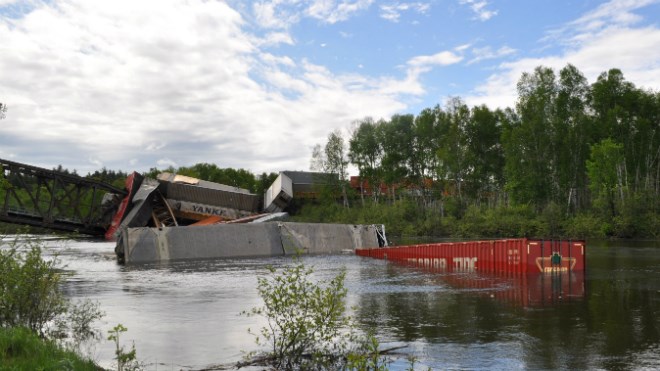Preliminary investigation by Canadian Pacific Railway has identified that one of the rail cars involved in the June 2 derailment and bridge collapse over Wanapitae River experienced a sudden and unexpected wheel bearing failure, said a CP spokesperson.
Ed Greenberg said the problem caused the rail car to derail just prior to the bridge. The derailed car then struck the bridge, causing further infrastructure damage.
On Sunday, the northbound freight train, comprised of 62 cars, derailed east of Sudbury, near Wanup. There were no injuries as a result of the incident.
“The safety of the surrounding community and the environment is our main priority,” said Greenberg in the press release.
As some of the rail containers came to rest in the nearby river, environmental experts have been deployed to the site and are working closely with community first responders.
An initial review of the incident site indicates approximately 24 containers are involved in the derailment. CP teams are on site now assessing which containers have made contact with the water and their condition.
CP is currently working to remove the cars from the river, assess the situation and determine the scope of repairs to the infrastructure, said Greenberg.
CP has an extensive network of electronic wayside train inspection systems.

Two train cars that floated down Wanapitae River when a train derailed near Wanup are seen stuck in some rapids near Highway 69. Photo by Arron Pickard.p
One of the main types of detectors on CP's system examines the temperature of every rail car’s wheel.
This train passed by nine of these detectors on its route toward Sudbury. Each of these detectors showed all wheels and bearings were a normal and acceptable temperature.
There was no indication of any bearing problems. The two detectors closest to the incident site were inspected today and verified to be working as intended.
“Our early investigation indicates this incident is the result of an unexpected and catastrophic wheel bearing failure that could not have been detected in advance,” said Greenberg. “Had the bearing detector indicated an issue, the crew would have been immediately advised and had an opportunity to stop the train.
“This is similar to a properly maintained and serviced passenger vehicle that showed no dashboard alarm indicators prior to experiencing a blown tire. In this same way, it was undetectable and unpreventable.
“We are working on identifying the types of consumer products within the containers involved in the derailment. Preliminary inspection indicates there are no materials or products of concern to the public or environment.”
CP has detour routes available to continue with the transportation of customers’ shipments. CP continues to investigate along with local authorities and the Transportation Safety Board of Canada.
